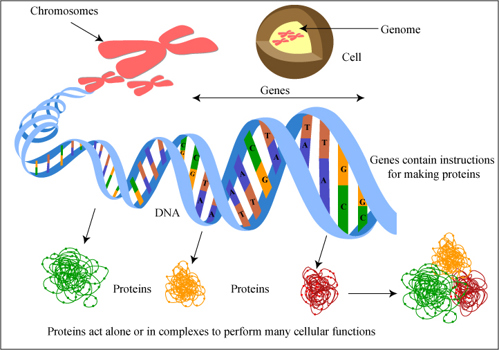
How is it possible for one sibling to have red hair and the other to have black hair?
August 28, 2012

- Related Topics:
- Complex traits,
- Hair color,
- Red hair
A curious adult from the United Kingdom asks:
"My mother has red hair, fair skin and freckles but her full brother has black hair and dark skin. No one ever believes that they are siblings because they look so different. How can this be possible?"
Brothers and sisters don’t always look as similar as you might expect. This often has to do with how lots of different genes happen to get passed down to each of them.
Luckily your situation is a whole lot simpler. We can explain your mom’s and your uncle’s differences with a single gene!
See, some traits like red hair, blue eyes, cystic fibrosis (CF) and lots of others are hidden in a person’s genes. They remain hidden until conditions are just right for them to be seen. Then, they can suddenly appear in one or more kids.

So sometimes two brown eyed parents have a blue eyed child or two parents without CF have a child with the disease. And sometimes two parents without red hair have a child with red hair.
So most likely your grandparents each had a hidden red hair gene and they each passed it down to your mother. She now had red hair! And they didn’t pass that gene to your uncle so he ended up with darker hair.
What makes your uncle and mom so easy to explain is that the gene involved in red hair is also involved in other traits like fair skin and freckles. They come as a package deal.
So your mom ended up a fair skinned, freckled redhead and your uncle a dark skinned brunette because of a single gene. This same kind of thing happened recently to a couple in England who had one fair skinned red haired twin and another twin with dark skin and black hair. Talk about hard to explain!
This gives you a general idea about how your mom and uncle ended up looking so different. But now let’s get into the details. In the end you’ll be able to see why your mom has red hair, fair skin and freckles and your uncle doesn’t.
The “Red Hair” Gene
Genes are the instructions for making a person. There are many genes in the body, and each gene has the instructions for one small part of you. So there are many genes involved in eye color, a different few in hair color and so on.
Genes come in different versions, which can lead to different traits. For example, there is a hair color gene (called MC1R) that comes in a red and a not-red version.

We also have two copies of each of our genes, one from each parent. So you can have two red MC1Rs, two not-red MC1Rs or one of each.
OK back to it. When you have two red MC1Rs, it’s obvious that you will have red hair. Same thing with two not-red MC1Rs – you won’t have red hair. But how about having one of each? Which one wins?
It turns out that some versions of a gene are weaker than others, and so their instructions are hidden when a stronger gene is around. The red MC1R gene is one of those weaker genes. So, when you have both the red and the not-red MC1Rs, the not-red version wins. You won’t have red hair.
Geneticists call these hidden genes “recessive”, and the stronger ones “dominant”. You need two recessive genes for the hidden trait to show.
To make things a bit simpler from here on out, we’ll do what geneticists do. We’ll call the not-red version, R, and the red version, r.
So, people have red hair because both of their MC1R genes are red (they are rr). Once a dominant not-red gene is present (either RR or Rr), the stronger trait shows up and the hidden trait will go back into hiding.
So your mom is clearly rr because of her red hair. Because your uncle does not have red hair, he could be RR or Rr. As you’ll see below, my money is on him being RR.
Two Carriers Can Have Very Different Looking Children
Your grandparents most likely each have one red and not-red gene (they are both Rr). They carry the hidden red gene, but most likely do not have red hair themselves. People who carry a hidden gene without showing the associated trait are called “carriers”.
Let’s see what combinations two carrier parents can produce. Each parent has a 50% chance of passing an R to their child and a 50% chance of passing an r.

As you can see from the table, each child has a 25% chance for being RR, a 50% chance for being Rr, and a 25% chance for being rr. From this quick math, you see that the chance for being born with red hair (rr genes) is only 25%.
Most likely, your grandparents both passed red genes (rr) to your mom. And because the red hair gene also has the instructions for fair skin and freckles (remember the package deal?), your mother has red hair, fair skin, and freckles.
Because your uncle doesn’t have red hair, he most likely got at least one not-red gene from one or both of your grandparents. He’s either RR or Rr. My guess, though, is that he is probably RR.
This is because lots of carriers happen to have fair skin, freckles, and/or lighter hair too. Not always, but sometimes they do.
Since your uncle has darker skin, odds are he got an R from each parent and so is RR. This isn’t a for sure thing as there are carriers with darker skin and no freckles. But this is the easiest explanation for the big difference between the two of them.
So there you have it. All we need is a single gene out of 25,000 to explain these differences between your mom and your uncle. Imagine what the other 24,999 might explain!

Author: Widya Mulyasasmita
When this answer was published in 2012, Widya was a Ph.D. candidate in the Department of Bioengineering, studying regenerative medicine and protein engineering in Sarah Heilshorn’s laboratory. Widya wrote this answer while participating in the Stanford at The Tech program.
 Skip Navigation
Skip Navigation
